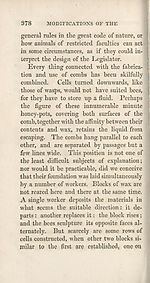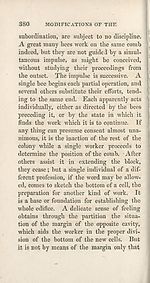Download files
Complete book:
Individual page:
Thumbnail gallery: Grid view | List view

1
AECHITECTURE OF BEES. 379
» each side, equally removed from it, and
[ parallel. These very soon become small
combs, for the bees work with astonishing
: rapidity; and in a short time we discover
other two, constructed in a position parallel
to the preceding. All are extended in pro¬
portion to their earlier origin: that in the
middle, being the farthest advanced, exceeds
! those parallel to its two faces by some rows
| of cells; and the latter exceed those follow-
5 ing them by a similar quantity. Thus, the
? greater part of both surfaces of the comb
are always concealed by those next to them.
I shall not attempt to explain how the
bees take such accurate measurements, and
know the direction parallel to the original
comb. But were they permitted to rear
different blocks in the roof of their hive at
the same time, it is obvious that the combs
neither would be parallel, nor at suitable
| distances.
It is invariably a single bee that selects
and determines the site of the first cavity,
which being established, serves to direct all
the ulterior labours. Did each of several
workers sketch a cell at once, the symmetry
to result from their operations would be en¬
dangered; for these insects, strangers to
AECHITECTURE OF BEES. 379
» each side, equally removed from it, and
[ parallel. These very soon become small
combs, for the bees work with astonishing
: rapidity; and in a short time we discover
other two, constructed in a position parallel
to the preceding. All are extended in pro¬
portion to their earlier origin: that in the
middle, being the farthest advanced, exceeds
! those parallel to its two faces by some rows
| of cells; and the latter exceed those follow-
5 ing them by a similar quantity. Thus, the
? greater part of both surfaces of the comb
are always concealed by those next to them.
I shall not attempt to explain how the
bees take such accurate measurements, and
know the direction parallel to the original
comb. But were they permitted to rear
different blocks in the roof of their hive at
the same time, it is obvious that the combs
neither would be parallel, nor at suitable
| distances.
It is invariably a single bee that selects
and determines the site of the first cavity,
which being established, serves to direct all
the ulterior labours. Did each of several
workers sketch a cell at once, the symmetry
to result from their operations would be en¬
dangered; for these insects, strangers to
Set display mode to:
![]() Universal Viewer |
Universal Viewer | ![]() Mirador |
Large image | Transcription
Mirador |
Large image | Transcription
| Antiquarian books of Scotland > Curiosities & wonders > New observations on the natural history of bees > (413) |
|---|
| Permanent URL | https://digital.nls.uk/128810823 |
|---|
| Description | Thousands of printed books from the Antiquarian Books of Scotland collection which dates from 1641 to the 1980s. The collection consists of 14,800 books which were published in Scotland or have a Scottish connection, e.g. through the author, printer or owner. Subjects covered include sport, education, diseases, adventure, occupations, Jacobites, politics and religion. Among the 29 languages represented are English, Gaelic, Italian, French, Russian and Swedish. |
|---|

